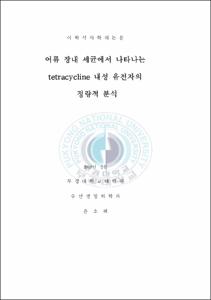어류 장내 세균에서 나타나는 tetracycline 내성 유전자의 정량적 분석
- Alternative Title
- Quantitation of tet genes in the intestinal microflora of fish
- Abstract
- This study was investigated the proportion of tetracycline (Tc) resistant bacteria with quantitative analysis of tetracycline resistance genes (tet genes) in fish intestines. Proportion of antibiotic resistance bacteria of ornamental fishes in Korea (20~30%) appeared to be the lowest level compared to that of other Asian countries (60~65%). In case of cultured marine fish, the Tc resistant proportion was very low (10~20%). And the determination and distribution of tet genes in Tc resistant bacteria using conventional multiplex PCR (multi PCR) showed diverse tet genes in ornamental fish but tet(B) showed mainly in marine fishes.
We reported here the development, validation and use of multiplex real-time PCR (multi qPCR) for both detection and quantification of various efflux tet genes,: tet(A), tet(B), tet(C), tet(D), tet(E) and tet(G), common in microflora of aquatic environment by high use of tetracycline. For multi qPCR of this study, two sets of DNA standards were prepared; purified 6 different plasmids contain each specific tet gene and sample-derived tet gene amplicons purified from multiPCR products using template DNA extracted from microflora in samples. The multi qPCR assays with two different standards, plasmid and amplicon, were significantly correlated in quantification tet genes in fish stool DNA. And we sured that qPCR assay used amplicon standard-degenerated primer had no difference with qPCR assay used plasmid standard-specific primer in tet gene copy number. The abundances of two tet gene groups (tet(A/C/G), tet(B/D/E)) parted according to their homologies were determined by comparing with sum of the tet genes quantified with degenerated primer sets separately. In imported ornamental fish, abundance of tet(A/C/G) was higher than tet(B/D/E) and it was opposed in domestic ornamental fish. In marine fish, tet(B/D/E) was higher than the other group, constantly, independent of fish species. We also examined the relationship between the frequency of Tc resistance colonies on the conventional agar plate and abundances analyzed by qPCR. These two assays for tet gene load in Tc resistant bacteria also significantly correlated each other, and evidenced the potential of qPCR for determination of the load of Tc resistant bacteria with involved tet gene in the microflora in aquatic environment.
- Issued Date
- 2008
- Awarded Date
- 2008. 2
- Type
- Dissertation
- Keyword
- tet gene real-time PCR stool DNA
- Publisher
- 부경대학교 대학원
- Alternative Author(s)
- Yoon, So Hye
- Affiliation
- 부경대학교 대학원
- Department
- 대학원 수산생명의학과
- Advisor
- 정현도
- Table Of Contents
- Ⅰ. 서론 = 1
Ⅱ. 재료 및 방법 = 5
1. 어류 장내 세균 = 5
1-1. 어류 채집 = 5
1-2. 장내 세균 분석 = 7
2. Conventional multiplex PCR amplification = 8
2-1. Primer = 8
2-2. Total Nucleic acid 분리 = 11
2-3. Multiplex PCR = 11
3. Real-time PCR의 도입 = 12
3-1. Primer 제작 = 12
3-2. Stool DNA 분리 = 15
3-3. Stool DNA를 이용한 primer의 특이성 = 15
3-4. Real-time PCR을 standard DNA 제조 = 16
3-4-1. Plasmid standard의 제조 = 16
3-4-2. Amplicon standard의 제조 = 16
3-4-3. Standard DNA의 정량 = 17
3-5. Real time PCR의 최적화 = 17
4. 어류 장내 microflora number와 16s rDNA gene copy값과의 관계 = 20
5. Multiplex real-time PCR의 활용 = 21
5-1. tet gene의 그룹화 = 21
5-2. Spiking test = 23
5-3. Single qPCR과 multi qPCR의 실시 = 23
5-4. 장내 세균 tet 유전자의 정량적 분석 = 24
Ⅲ. 결과 = 25
1. 어류 장내 세균의 분포 = 25
2. 어류 장내 세균의 Tc 내성 비율 = 28
3. Tetracycline 내성 유전자 분포 조사 = 30
4. Real-time PCR assay의 확립 = 42
4-1. 제작된 primer의 특이성 확인 = 42
4-2. Plasmid standard와 amlplicon standard 사용에 따른 tet gene = 44
5. Multiplex real-time PCR = 48
5-1. Spiking test = 48
5-2 Single qPCR과 multi qPCR의 copy 값 비교 = 50
6. 어류 장내 Tc 내성 유전자의 정량 = 52
Ⅳ. 고찰 = 57
Ⅴ. 요약 = 69
Ⅵ. 감사의 글 = 71
Ⅶ. 참고 문헌 = 73
- Degree
- Master
- Files in This Item:
-
-
Download
 어류 장내 세균에서 나타나는 tetracycline 내성 유전자의 정량적 분석.pdf
기타 데이터 / 903.43 kB / Adobe PDF
어류 장내 세균에서 나타나는 tetracycline 내성 유전자의 정량적 분석.pdf
기타 데이터 / 903.43 kB / Adobe PDF
-
Items in Repository are protected by copyright, with all rights reserved, unless otherwise indicated.